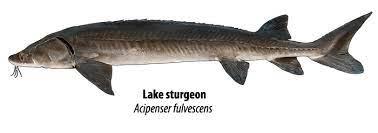The Great Lakes are a beautiful part of our country and a source of life for many. From general freight, to recreation, to drinking water for over 30 million people, our lakes sustain us. Our record-breaking Great Lakes have a unique and long history.
The Great Lakes region sits on weaker sedimentary rock, making eroding easier. Before the glaciers, there were many millennia when the rock was being carved by streams. When the glaciers came along the space carved out by streams became deeper, wider, and longer. As the glaciers began to recede, they opened up waterways and lake levels began to sink. After the glaciers receded, the earth’s crust began to rebound, as the glaciers had compressed it. This closed up some of the waterways, and the lake level began to rise again. The process of rebounding is still happening today.

The great lakes are home to many interesting animals, like the Rock Sturgeon (Acipenser Fulvescens). These amazing fish have been around since the early Jurassic period, with very little change since then. These sturgeons can live very long lives, with the males living up to 55 years, and the females living up to 150 years! Unfortunately, due to overfishing and destruction of habitat, Michigan classified Rock Sturgeon as threatened in 1994. Efforts to replenish the population are being made state-wide. In a collaboration by Michigan State University, the Michigan Department of Natural Resources, Tower-Kleber Limited Partnership, and many more, there has been a significant effort on raising sturgeon in the Great Lakes, rivers, and inland lakes!
 Zebra mussels (Dreissena polymorpha) are a big problem in the Great Lakes. These invasive species originate from the Black and Caspian Seas but have since made their way into the Great Lakes, where they have become a big threat. These mussels will attach themselves to anything and everything they can, including boats, rocks, pipes, docks, and even native mussels! Due to the root-like structure, they use to attach, they are very hard to remove and spread very quickly. If boats or anything supposed to move is left in the water too long, these mussels can completely cover it and clog motors and decrease mobility. Zebra mussels are not only fast at multiplying, but they also filter the water much quicker than native mussels. Both their quick reproduction and filtration have led to a change in the environment of the water itself. This causes changes in plant life under the water and allows sight-based predators to see prey much easier, which messes with population numbers. Once they are in a body of water, they are very hard to remove. Prevention is key!
Zebra mussels (Dreissena polymorpha) are a big problem in the Great Lakes. These invasive species originate from the Black and Caspian Seas but have since made their way into the Great Lakes, where they have become a big threat. These mussels will attach themselves to anything and everything they can, including boats, rocks, pipes, docks, and even native mussels! Due to the root-like structure, they use to attach, they are very hard to remove and spread very quickly. If boats or anything supposed to move is left in the water too long, these mussels can completely cover it and clog motors and decrease mobility. Zebra mussels are not only fast at multiplying, but they also filter the water much quicker than native mussels. Both their quick reproduction and filtration have led to a change in the environment of the water itself. This causes changes in plant life under the water and allows sight-based predators to see prey much easier, which messes with population numbers. Once they are in a body of water, they are very hard to remove. Prevention is key!
Sources:
Great Lakes. (n.d.). Coast.noaa.gov. https://coast.noaa.gov/states/fast-facts/great-lakes.html#:~:text=The%20Great%20Lakes%20span%204%2C530
Herdendorf. (2004). Morphometric factors in the formation of Great Lakes coastal wetlands. Aquatic Ecosystem Health & Management., 7(2), 179–197. https://doi.org/10.1080/14634980490461515
Lake Sturgeon | National Wildlife Federation. (2019). National Wildlife Federation. https://www.nwf.org/Educational-Resources/Wildlife-Guide/Fish/Lake-Sturgeon
Michigan DNR and MSU celebrate 20 years of lake sturgeon research and management. (2022, April 13). OutdoorsFIRST. https://www.outdoorsfirst.com/article/michigan-dnr-and-msu-celebrate-20-years-of-lake-sturgeon-research-and-management/
National Park Service. (2017). Invasive Zebra Mussels (U.S. National Park Service). Nps.gov; National Park Service. https://www.nps.gov/articles/zebra-mussels.htm









